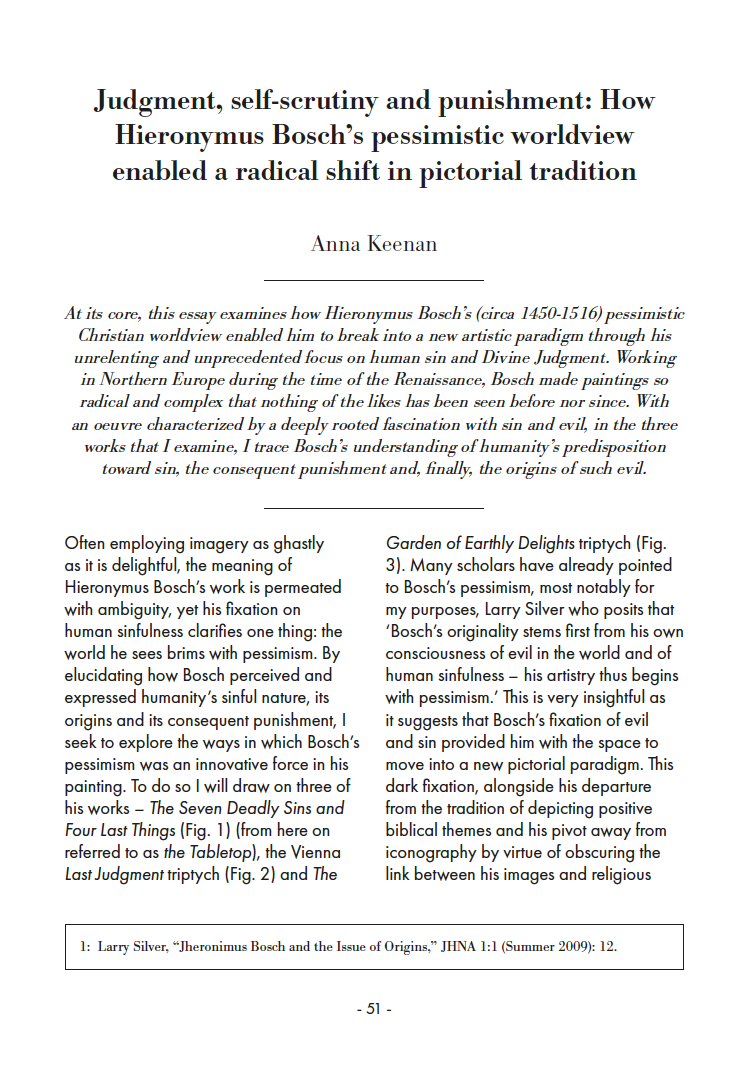Judgment, self-scrutiny and punishment
How Hieronymus Bosch’s pessimistic worldview enabled a radical shift in pictorial tradition
DOI:
https://doi.org/10.36399/GroundingsUG.14.144Keywords:
Art History, Hieronymus Bosch, Renaissance Studies, Sin, Christianity, Original Sin, EschatologyAbstract
At its core, this essay examines how Hieronymus Bosch’s (circa 1450-1516) pessimistic Christian worldview enabled him to break into a new artistic paradigm through his unrelenting and unprecedented focus on human sin and Divine Judgment. Working in Northern Europe during the time of the Renaissance, Bosch made paintings so radical and complex that nothing of the likes has been seen before nor since. With an oeuvre characterized by a deeply rooted fascination with sin and evil, in the three works that I examine, I trace Bosch’s understanding of humanity’s predisposition toward sin, the consequent punishment and, finally, the origins of such evil.
References
Aquinas, Thomas. (1911-1925). Summa Theologica. Translated by Fathers of the English Dominican Province. New York: Benziger.
Belting, Hans. (2002). Hieronymus Bosch, Garden of Earthly Delights. Munich: Prestel.
Gibson, Walter S. (1973). “Hieronymus Bosch and the Mirror of Man: The Authorship and Iconography of the “Tabletop of Seven Deadly Sins”.” OUD, Vol, 87, No. 4 205-226.
Glum, Peter. (1976). “Divine Judgment in Bosch’s Garden of Earthly Delights.” The Art Bulletin Vol. 58, No. 1 45-54.
Guevara, Felipe de. (1973). “Commentaries on Painting.” In Bosch in Perspective, by ed. James Snyder, 28-31. Englewood Cliffs: New Jersey: Prentice-Hall, Inc.
Ilsink, Matthijs, Koldewij A. M, and Ron et al Spronk. (2016). Hieronymus Bosch: painter and draughtsman: catalogue raisonne. ‘s-Hertogenbosch: Bosch Research and Conservation Project.
Koerner, Joseph. (2004). “Impossible Objects: Bosch’s Realism.” RES: Anthropology and Aesthetics, No. 46, Polemical Objects 73-97.
Peyer, Toos de. (2003). “Grillen and Grylli: The Diableries of Jheronmius Bosch.” In Jheronimus Bosch, his Patrons and his Public, by ed. Frances Kemp et al, 210-228. ‘s-Hertogenbosch: Jheronimus Bosch Art Centre.
Sigüenza, Fra José de. (1973). “History of the Order of St Jerome.” In Bosch in Perspective, by ed. James Snyder, 34-42. Englewood Cliffs, New Jersey: Prentince-Hall, Inc.
Silver, Larry. (2016). “Crimes and Punishments. Bosch’s Hells.” In Bosch. The 5th Centenary Exhibition, by ed. Pilar Silva, 115-132. Madrid: Museo Nacional del Prado.
Silver, Larry. (2009). “Jheronimus Bosch and the Issue of Origins.” JHNA 1:1 1-21.

Downloads
Published
Issue
Section
License
Copyright (c) 2023 Anna Keenan

This work is licensed under a Creative Commons Attribution 4.0 International License.
The CC BY 4.0 license is a Creative Commons license. This is a non-copyleft free license that is good for art and entertainment works, and educational works. It is compatible with all versions of the GNU GPL; however, like all CC licenses, it should not be used on software. People are free to: Share — copy and redistribute the material in any medium or format; Adapt — remix, transform, and build upon the material for any purpose, even commercially. The licensor cannot revoke these freedoms as long as you follow the license terms. But they must conform to the following terms: Attribution — You must give appropriate credit, provide a link to the license, and indicate if changes were made. You may do so in any reasonable manner, but not in any way that suggests the licensor endorses you or your use. No additional restrictions — You may not apply legal terms or technological measures that legally restrict others from doing anything the license permits.
Please check individual article PDF copies to see if any additional restrictions apply.







